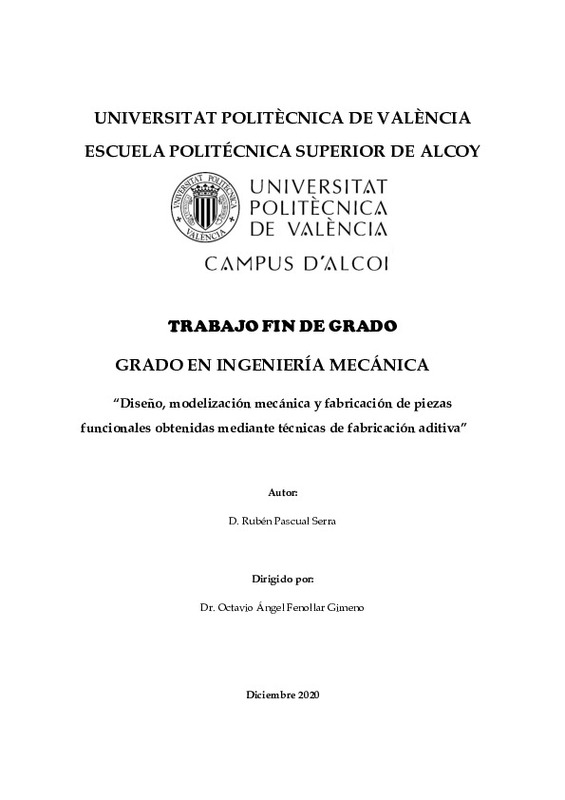|
Resumen:
|
[ES] En este trabajo de fin de grado se pretende desarrollar una metodología que sirva para poder estudiar el comportamiento mecánico de piezas funcionales obtenidas mediante técnicas de fabricación aditiva, más conocido ...[+]
[ES] En este trabajo de fin de grado se pretende desarrollar una metodología que sirva para poder estudiar el comportamiento mecánico de piezas funcionales obtenidas mediante técnicas de fabricación aditiva, más conocido como impresión 3D. Esta idea surge de la dificultad que se tiene en la actualidad para realizar estos estudios ya que muy pocos softwares incluyen herramientas específicas dedicadas a la simulación con estos diseños.
Para lograr este objetivo, se pretende replicar la pieza fabricada con esta técnica en un software de CAD, en este caso, SolidWorks, en su versión de 2019; creando diferentes modelos variando la estructura interna según diferentes patrones y porcentajes de relleno. Tras esto, se realizarán simulaciones mediante un modelo FEM donde se podrá observar el comportamiento mecánico de cada uno de los prototipos.
Se ha seleccionado un calzo para vehículos como pieza funcional ya que se ha encontrado interesante dado que no tiene una geometría excesivamente compleja que dificulte las simulaciones y se puede encontrar un estado tensional interesante ya que las cargas se van a encontrar distribuidas en una superficie curva. Además, la selección de esta pieza como base de los prototipos permitirá poder variar las condiciones de las cargas, jugando con las pendientes y la masa del vehículo. Con esto se podrá obtener una optimización de esta pieza en concreto, que será extrapolable a cualquier otra pieza funcional.
Durante el desarrollo del trabajo, se ha podido comprobar que patrones demasiado complejos o porcentajes de relleno demasiado elevados imposibilitan la validez de esta metodología puesto que los simuladores no son capaces de operar con la cantidad de nodos y grados de libertad que se generan. Sin embargo, se ha podido demostrar que para patrones y rellenos más sencillos es un método válido puesto que permitirá al usuario la optimización de su diseño previo a la impresión.
[-]
[EN] This final degree project aims to develop a methodology that serves to study the mechanical behavior of functional pieces obtained through additive manufacturing techniques, better known as 3D printing. This idea ...[+]
[EN] This final degree project aims to develop a methodology that serves to study the mechanical behavior of functional pieces obtained through additive manufacturing techniques, better known as 3D printing. This idea arises from the current difficulty in conducting these studies, since very few software include specific tools focused on simulation with these designs.
In order to achieve this objective, it is intended to replicate the piece manufactured with this technique in a CAD software, in this case, SolidWorks, in its 2019 version; creating different models by varying the internal structure according to different patterns and filling percentages. After this, simulations will be carried out using a FEM model where the mechanical behavior of each one of the prototypes can be observed.
A vehicle chock has been selected as a functional piece since it has been found interesting since it does not have an excessively complex geometry that makes simulations difficult and an interesting tension state can be found since the loads are going to be distributed in a curved surface . In addition, the selection of this piece as the basis of the prototypes will allow to vary the load conditions, playing with the slopes and the mass of the vehicle, with this it will be possible to obtain an optimization of this particular piece, which will be extrapolated to any other functional piece.
During the development of the project, it has been found that patterns that are too complex or filling percentages that are too high make the validity of this methodology impossible since the simulators are not capable of operating with the number of nodes and degrees of freedom that are generated. However, it has been shown that for simpler patterns and fillings it is a valid method since it will allow the user to optimize their design prior to printing.
[-]
|





![ZIP archive [ZIP]](/themes/UPV/images/zip.png)


